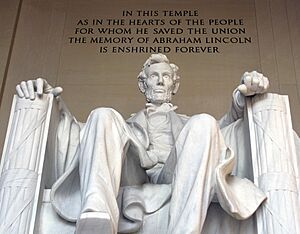Royal Cortissoz facts for kids
Royal Cortissoz (born February 10, 1869, died October 17, 1948) was an American art historian. For many years, he worked as an art critic for a newspaper called the New York Herald Tribune. He strongly supported traditional art styles. He did not like modern art. He once said modern art would "someday prove a kind of 'dud'," meaning it wouldn't last or be important.
He wrote the famous words carved above the Abraham Lincoln statue. This statue is inside the Lincoln Memorial in Washington, D.C. The words say: "In this temple, as in the hearts of the people for whom he saved the Union, the memory of Abraham Lincoln is enshrined forever."
Early Life and Career
Cortissoz was born in Brooklyn, New York. His father was from England, and his mother was from Martinique. When he was 16, he started training as an architect. He worked for six years at a company called McKim, Mead, and White.
After that, he joined the staff of the Commercial Advertiser newspaper. In 1891, he moved to the New York Tribune. There, he wrote about culture and eventually became the art editor. He loved art from a young age. However, he never formally studied or practiced art himself. Instead, he was very good with words. This led him to become an art critic. He said he became one "by spontaneous combustion," meaning it happened naturally.
Working as a journalist was very busy. The pressure to make the Tribune a leader in culture was high. This led to him feeling very unwell, which was called neurasthenia at the time. He got better after a trip around Cape Horn. But he continued to feel worried and had physical problems caused by stress for the rest of his life.
Royal Cortissoz as an Art Critic
As an art critic, Cortissoz believed his job was to help everyone appreciate art. He didn't just write about paintings. He also wrote a lot about jewelry, rare book designs, architecture, furniture, and interior design. He thought art was very important for society to be healthy and happy. He often said that beauty could be found everywhere.
Cortissoz was so important that artists really wanted his praise. The people organizing a big art show in 1913, called the Armory Show, were worried about what he would think.
Cortissoz argued against modern art for several reasons. He thought abstract art was ugly. He also disagreed with the idea that art didn't have to look like real life. In 1923, he compared new European modern artists coming to America to the issue of immigration. He even made up a negative term, "Ellis Island art," to describe these new artists. He wanted to make their rising fame in the art world seem less important. However, this term did not become popular.
He also disliked how modern artists often ignored the past. He didn't like that they dismissed people who didn't like their work. Cortissoz felt this attitude would make people think art was strange or crazy. He worried they would then lose interest in art. Over the years, Cortissoz criticized many modern art styles. These included Cubism, German Expressionism, Dada, Surrealism, and abstract expressionism. He thought artists like Pablo Picasso, Henri Matisse, and Piet Mondrian were too focused on themselves. In 1927, he wrote that these artists would "go to the scrap heap" eventually. He worried they were "ruining the younger generation."
However, he did praise some American modern artists. He liked those who still used traditional art techniques. These artists included Arthur B. Davies, Guy Pène du Bois, and Georgia O'Keeffe.
Personal Life
In 1897, Cortissoz married Ellen MacKay Hutchinson. She was a literary editor at the Tribune newspaper. She passed away in August 1933. They did not have any children. Cortissoz died in Manhattan from a heart problem.
Honors and Awards
Royal Cortissoz received several honors and was part of important groups:
- D.H.L. degree from Wesleyan University
- Chevalier (a special honor) in the Order of Leopold from Belgium
- Member of The American Academy of Arts and Letters
- Trustee for the American Academy in Rome
- Honorary member of the American Institute of Architects
- Honorary Fellow at the Metropolitan Museum of Art
- Received a medal for his great service in fine arts in 1931 from the American Art Dealers Association



